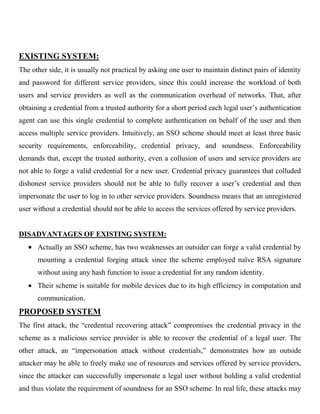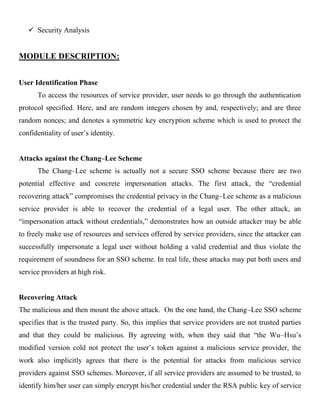Security analysis of a single sign on mechanism for distributed computer networks
- 1. Security Analysis of a Single Sign-On Mechanism For Distributed Computer Networks ABSTRACT: The Single sign-on (SSO) is a new authentication mechanism that enables a legal user with a single credential to be authenticated by multiple service providers in a distributed computer network. Recently, Chang and Lee proposed a new SSO scheme and claimed its security by providing well-organized security arguments. In this paper, however, we demonstrative that their scheme is actually insecure as it fails to meet credential privacy and soundness of authentication. Specifically, we present two impersonation attacks. The first attack allows a malicious service provider, who has successfully communicated with a legal user twice, to recover the user’s credential and then to impersonate the user to access resources and services offered by other service providers. In another attack, an outsider without any credential may be able to enjoy network services freely by impersonating any legal user or a nonexistent user. We identify the flaws in their security arguments to explain why attacks are possible against their SSO scheme. Our attacks also apply to another SSO scheme proposed by Hsu and Chuang, which inspired the design of the Chang–Lee scheme. Moreover, by employing an efficient verifiable encryption of RSA signatures proposed by Ateniese, we propose an improvement for repairing the Chang–Lee scheme. We promote the formal study of the soundness of authentication as one open problem. GLOBALSOFT TECHNOLOGIES IEEE PROJECTS & SOFTWARE DEVELOPMENTS IEEE FINAL YEAR PROJECTS|IEEE ENGINEERING PROJECTS|IEEE STUDENTS PROJECTS|IEEE BULK PROJECTS|BE/BTECH/ME/MTECH/MS/MCA PROJECTS|CSE/IT/ECE/EEE PROJECTS CELL: +91 98495 39085, +91 99662 35788, +91 98495 57908, +91 97014 40401 Visit: www.finalyearprojects.org Mail to:ieeefinalsemprojects@gmail.com
- 2. EXISTING SYSTEM: The other side, it is usually not practical by asking one user to maintain distinct pairs of identity and password for different service providers, since this could increase the workload of both users and service providers as well as the communication overhead of networks. That, after obtaining a credential from a trusted authority for a short period each legal user’s authentication agent can use this single credential to complete authentication on behalf of the user and then access multiple service providers. Intuitively, an SSO scheme should meet at least three basic security requirements, enforceability, credential privacy, and soundness. Enforceability demands that, except the trusted authority, even a collusion of users and service providers are not able to forge a valid credential for a new user. Credential privacy guarantees that colluded dishonest service providers should not be able to fully recover a user’s credential and then impersonate the user to log in to other service providers. Soundness means that an unregistered user without a credential should not be able to access the services offered by service providers. DISADVANTAGES OF EXISTING SYSTEM: Actually an SSO scheme, has two weaknesses an outsider can forge a valid credential by mounting a credential forging attack since the scheme employed naïve RSA signature without using any hash function to issue a credential for any random identity. Their scheme is suitable for mobile devices due to its high efficiency in computation and communication. PROPOSED SYSTEM The first attack, the “credential recovering attack” compromises the credential privacy in the scheme as a malicious service provider is able to recover the credential of a legal user. The other attack, an “impersonation attack without credentials,” demonstrates how an outside attacker may be able to freely make use of resources and services offered by service providers, since the attacker can successfully impersonate a legal user without holding a valid credential and thus violate the requirement of soundness for an SSO scheme. In real life, these attacks may
- 3. put both users and service providers at high risk In fact; this is a traditional as well as prudential way to deal with trustworthiness, since we cannot simply assume that beside the trusted authority, all service providers are also trusted. The basic reason is that assuming the existence of a trusted party is the strongest supposition in cryptography but it is usually very costly to develop and maintain. In particular defined collusion impersonation attacks as a way to capture the scenarios in which malicious service providers may recover a user’s credential and then impersonate the user to login to other service providers. It is easy to see that the above credential recovery attack is simply a special case of collusion impersonation attack where a single malicious service provider can recover a user’s credential. It must be emphasized that impersonation attacks without valid credentials seriously violate the security of SSO schemes as it allows attackers to be successfully authenticated without first obtaining a valid credential from the trusted authority after registration. ADVANTAGES OF PROPOSED SYSTEM: The authors claimed to be able to: “prove that and are able to authenticate each other using our protocol.” but they provided no argument to show why each party could not be impersonated by an attacker. Second, the authors did discuss informally why their scheme could withstand impersonation attacks. The authors did not give details to show how the BAN logic can be used to prove that their scheme guarantees mutual authentication. In other words, it means that in an SSO scheme suffering these attacks there are alternatives which enable passing through authentication without credentials. MODULES: User Identification Phase Attacks against the Chang–Lee Scheme Recovering Attack Non-interactive zero-knowledge(NZK)
- 4. Security Analysis MODULE DESCRIPTION: User Identification Phase To access the resources of service provider, user needs to go through the authentication protocol specified. Here, and are random integers chosen by and, respectively; and are three random nonces; and denotes a symmetric key encryption scheme which is used to protect the confidentiality of user’s identity. Attacks against the Chang–Lee Scheme The Chang–Lee scheme is actually not a secure SSO scheme because there are two potential effective and concrete impersonation attacks. The first attack, the “credential recovering attack” compromises the credential privacy in the Chang–Lee scheme as a malicious service provider is able to recover the credential of a legal user. The other attack, an “impersonation attack without credentials,” demonstrates how an outside attacker may be able to freely make use of resources and services offered by service providers, since the attacker can successfully impersonate a legal user without holding a valid credential and thus violate the requirement of soundness for an SSO scheme. In real life, these attacks may put both users and service providers at high risk. Recovering Attack The malicious and then mount the above attack. On the one hand, the Chang–Lee SSO scheme specifies that is the trusted party. So, this implies that service providers are not trusted parties and that they could be malicious. By agreeing with, when they said that “the Wu–Hsu’s modified version cold not protect the user’s token against a malicious service provider, the work also implicitly agrees that there is the potential for attacks from malicious service providers against SSO schemes. Moreover, if all service providers are assumed to be trusted, to identify him/her user can simply encrypt his/her credential under the RSA public key of service
- 5. provider. Then, can easily decrypt this cipher text to get ’s credential and verify its validity by checking if it is a correct signature issued by . In fact, such a straightforward scheme with strong assumption is much simpler, more efficient and has better security, at least against this type of attack. Non-interactive zero-knowledge (NZK) The basic idea of VES is that Alice who has a key pair of signature scheme signs a given message and encrypts the resulting signature under the trusted party’s public key, and uses a non-interactive zero-knowledge (NZK) proof to convince Bob that she has signed the message and the trusted party can recover the signature from the cipher text. After validating the proof, Bob can send his signature for the same message to Alice. For the purpose of fair exchange, Alice should send her signature in plaintext back to Bob after accepting Bob’s signature. Security Analysis The security of the improved SSO scheme by focusing on the security of the user authentication part, especially soundness and credential privacy due to two reasons. On the one hand, the unforgeability of the credential is guaranteed by the unforgeability of RSA signatures, and the security of service provider authentication is ensured by the unforgeability of the secure signature scheme chosen by each service provider. SYSTEM CONFIGURATION:- HARDWARE CONFIGURATION:- Processor -Pentium –III Speed - 1.1 Ghz
- 6. RAM - 256 MB(min) Hard Disk - 20 GB Floppy Drive - 1.44 MB Key Board - Standard Windows Keyboard Mouse - Two or Three Button Mouse Monitor - SVGA SOFTWARE CONFIGURATION:- Operating System : Windows XP /7 Programming Language : JAVA Java Version : JDK 1.6 & above. REFERENCE: Guilin Wang, Jiangshan Yu, and Qi Xie, “Security Analysis of a Single Sign-On Mechanism for Distributed Computer Networks”, IEEE TRANSACTIONS ON INDUSTRIAL INFORMATICS, VOL. 9, NO. 1, FEBRUARY 2013.





